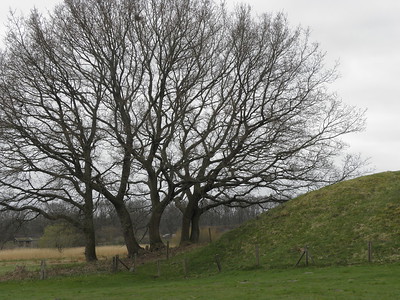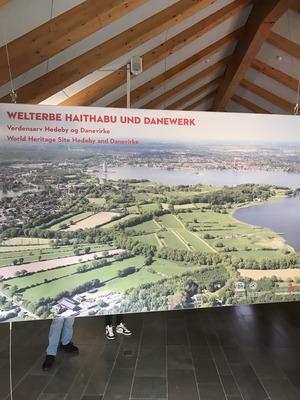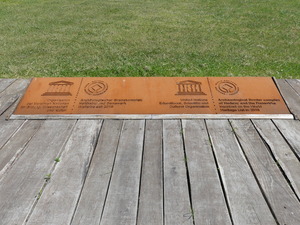Hedeby and Danevirke

The Archaeological Border Complex of Hedeby and the Danevirke comprises the archeological site of a medieval trading network that existed between Western and Northern Europe.
The Danevirke was a 33km long fortified wall that marked the border between the emerging Danish kingdom and the Frankish Empire. Hedeby was a market town that expanded due to the growing economic power of the Danish Vikings.
Community Perspective: the Viking Museum at Haithabu provides the most comprehensive overview, although its structures are mostly reconstructions as not much of the originals are left beyond the earthworks. Nan provides a local perspective, and Clyde describes a full visit including the Dannewerk museum.
Map of Hedeby and Danevirke
Community Reviews
Clyde

I visited this WHS in May 2020 as a long road trip after two months of lockdown. I visited both inscribed main locations starting with a visit just outside the town of Dannewerk (or Dannevirke) and then heading to Haithabu (or Hedeby).
Make sure to follow the brown sign to Dannewerk Museum not the yellow one to Dannewerk town. I parked for free near the small museum. It is possible to visit the 22 inscribed locations between Dannewerk and Haithabu completely free of charge and as such these are open 24/7. The small Dannewerk museum entrance costs 5 euros while the bigger Haithabu Viking Museum costs 8 euros to visit.
As is the case with all Viking Age sites, there isn't much to see apart from the ubiquitous earthwork mounds and ramparts as wood isn't a durable medium. That said, and after heeding Nan's advice not to expect much of this WHS, I still was positively surprised by the scale of the curved walls near Dannewerk, stretching for around 30 km and connecting Dannewerk and Haithabu between the Baltic Sea and the North Sea.
Dannewerk is a fortification constructed by the Danes in the Early to High Middle Ages to protect themselves against peoples from the South. It is an archaeological and cultural monument of European significance with elements of a historical cultural landscape which have almost disappeared elsewhere. A brick section of the 12th century curved walls concealed beneath the earth, grass and oak trees can be seen quite close to the museum. Being exposed to the elements, means that it requires constant restoration with more bricks and metal structures to reinforce the wall and prevent mudslides. The brick wall is believed to be one of the oldest brickwork structures in Northern Europe and certainly the oldest structure in this part of Germany.
King Valdemar the Great of Denmark had the wall built, which meant yet another phase of modernisation for Dannewerk. His intention was to defend the kingdom of Denmark from Slavic and Saxon raids as engraved on his tombstone. It was also a demonstration of his power aimed at the German king, even though I tend to agree with Nan who described him as a 'poor king' when compared to other kings. Further on from the brick wall is a reconstructed defensive fortification (perfect for drone photography) which is a relic of the German-Danish war of 1864 over the national affiliation of the Duchy of Schleswig. The Danes built 27 bastions for their cannons and modifying the medieval earthworks.
Next stop was the bigger parking lot of the Haithabu Viking Museum in Busdorf. Instead of heading left towards the big museum with metallic structures resembling the reconstructed wooden Viking structures of Trelleborg in Denmark, heading right will bring you at the massive semi-circular ramparts of the Viking Age commercial settlement and port of Haithabu which are also part of the pilgrimage route to far away Santiago de Compostela. Due to the several trees these ramparts are less easy to appreciate than those at Dannewerk. These ramparts were built by Danish king Harald Bluetooth in the second half of the 10th century who also ordered the connecting wall between Dannewerk and Haithabu afterwards.
Reconstructed wooden dwellings, similar to the pile dwellings in Unteruhldigen, are now located on the site believed to have been the town centre. Parallel to the banks of the pretty Haddebyer Noor lake, formerly a small arm of the Schlei inlet of the Baltic Sea, was a wooden plank road with paths towards the water leading to harbour jetties, which also served as a market place. Northwest of the settlement there were numerous workshops for various crafts, so much so that production waste such as iron slag and glass was found there. Southwest of the settlement instead, there was quite a large cemetery.
At the end of the 11th century, Schleswig succeeded Haithabu, even though the abandoned trading centre was never built over and it is believed that as much as 95% of what remains is still underground waiting to be excavated. The area near Haithabu is much more scenic for a stroll than Dannewerk and it reminded me of the Hovgarden and Birka WHS in Sweden, albeit without any rune stone.
There are rather large rusty metal UNESCO inscription plaques in Dannewerk as well as Haithabu. The overall experience was quite similar to that of Kernave in Lithuania and as such the OUV, if any, is very difficult to grasp. However, since through this tick I completed Germany again and thanks to Nan, I rated my WHS experience with 2 stars.
I had already visited the nearby WHS of Lubeck, Bremen, Speicherstadt and Wismar a couple of years before but in the meantime the Wadden Sea in Germany was added too so afterwards, again thanks to Nan's guidance, I also visited the German part near Husum, opposite the German Wadden Sea islands, during low tide (without the muddy walk many seem to make, so much so that a public shower is available at the end of the pier).
Jakob Frenzel

July 2019 - on our trip from Hamburg to Denmark we had to stop here for sure. Another German WHS, eventually we want to visit them all. My father told me about his classtrip he did there in the 60th. It was already then a famous site. However, all there is, are some reconstructed moviesetting like huts, a giant grassed dike and many sheep. For us the most interesting part. Museum, souvenirs and the small wooden huts did not interest us that much so we did not bother to pay the rather high entrance fees.
Nice stop, because of the surroundings but if you are not interested in Viking age, than its no highlite visiting WHS.
Nan

Being born and raised in Schleswig Holstein, the Northern most state of Germany, I was made to visit Haithabu already at a young age. It features prominently in the local history lessons and we were taken there in elementary school as a school trip. My main memory was that it was fairly mundane: a big earthen circle and grass meadows. The reason the site is featured so heavily in the curriculum of local schools is that there actually is very little else of "early" history in Schleswig Holstein.
Haithabu lay on the borders of the Holy Roman Empire of Charlemagne. Being strategically located on the Schlei, a bay on the Baltic Sea, it functioned as a major trade hub between the Holy Roman Empire and Northern Europe. For a time it was probably the largest urban settlement in Northern Europe, albeit that doesn't mean much. It is assumed up to 2000 people lived in Haithabu at it's peak. To put that into perspective, Cologne had 15.000 inhabitants, let alone Constantinople with at least 100.000.
The most interesting story I remember from my history lessons in elementary school is that the vikings sailed the Schlei westward where they would land their ships and transport goods and ships via land for 18km to reach a tributary to the Eider river. Via the Eider they were able to reach the North Sea. This way they saved themselves the long and dangerous voyage around the Skagerak. Nowadays the sources are not sure if only the goods were moved or also the boats. Personally I prefer the image of Viking boats being landed and then rolled across land.
Eventually Haithabu was disbanded and Schleswig on the the other side of the Schlei became the principal settlement of the area. So much so that the modern German state is still called by the town's name: Schleswig-Holstein.
Having visited as an adult a few years back I think mundane still describes the site quite well. Just keep in mind that at the same time Haithabu was built Charlemagne had the Aachen Cathedral erected.
Getting There
Take the train to Schleswig and from there either a bus or a 40min walk. Deutsche Bahn has the details.
While You Are There
There is an on-site museum showing a few of the finds. They also reconstructed some of the original buildings to give you an impression of the living conditions. If you have a car, you can also visit several parts of the border wall (Danewerk).
In addition you should visit the state museum at Schloss Gottorf to see some of the finds. Schleswig itself has a nice reputation and the church features and impressive altar piece. Last but not least, the Schlei is quite a nice bay, especially if you traverse it by boat.
If you plan to travel on, this should be part of the Hamburg Hotspot, specifically Lübeck and Wadden Sea are well within reach. You can also continue North to Christianfeld and Jelling.
Tsunami
Japan / USA / Europe - 17-Oct-17 -

Some man involved in nominating this site for Germany came over to speak in my class during Winter Semester 2015-16 when I was still enrolled in the master's degree program "World Heritage Studies" in Germany and said that they had given up nominating this site as a transnational serial site with 4 other state parties and had decided to go alone at it; thus another nomination called "Hedeby and Danevirke, an archaeological border landscape."
I took a Flix bus from Hamburg, which dropped me off at some gas station in Schleswig about 3 km away from the outdoor museum area. But luckily within a few minutes I found an elderly woman who lives in Busdorf near the museum and who gave me a ride to the museum area.
I had seen this kind of reconstructed Viking houses in Lofoten Islands in Norway, Birka in Sweden and Trelleborg in Denmark.
So I guess it may be a good idea to distinguish itself by presenting this area with such a different view point as archaeological border landscape with the remains of the earthwork.
Read more from Tsunami here.
Ralf Regele

I visited the Hedeby site, which is well developed for tourists, with a museum (closed at the moment for refurbishment), walking pathes and reconstructed houses. Hedeby (or Haithabu in German) was a well-sized city at the edge of the viking lands. As with other viking sites (like Birka or Trelleborg) the problem is that almost everything was built out of wood, so there is not much left of it but the earthworks. In the case of Hedeby, the earthen city walls are still standing (and walkable), but most of the area inside is empty. There are some quite nice reconstructions of viking houses, which will be the most interesting thing for most visitors. There are also demonstrations, market stalls and exhibition houses, so there is more to do than to stare at mounds. Also interesting is the visitable archaeological dig, although most finds seemed to be small things like nails or bone remains. The whole area is rather idyllic, with a nice lake and an undisturbed environment. It is a good place for hiking. As there are no nearby settlements today, getting there can be a problem. It is rather easy with a car, as the main highway from the north (e.g. to Jelling) to the south (e.g. to Hamburg) is quite close, but public transport might be difficult.
All in all, I had a very pleasant visit there, and really got a good impression of how they lived in the viking times. However, the most interesting things are reconstructions (Kind of like Unteruhldingen with the pile dwellings). Therefore it is hard to judge the worthiness and OUV of the site.
Visited May 2017
Importance: 3/5 Beauty: 2/5 Uniqueness: 4/5 Environment: 4/5 Experience: 4/5
Els Slots

I visited Danevirk and Hedeby on my way to the WHS of Jelling. There are several places where one can see the remains of the Danevirk (or Dannewerk in German), but the Viking Museum at Haithabu probably is the most worthwhile.
The Danevirk was the Viking's equivalent to Hadrian's Wall: built to keep out the barbarians. It covered a stretch of 30km in what is now the German state of Schleswig-Holstein (formerly in Denmark). Hedeby / Haithabu was the most important town in the region. It was located along the shortcut route between North Sea and Baltic Sea.
The Viking Museum at Haithabu has a modern presentation inside, though as so often there has not been found much of real interest from the Viking area. A lot of people seemed to have lost their money bag while getting on or off-board in the harbour!
The museum has a large outdoor part too. It holds a recreation of Haithabu in its original location, a part of the Dannewerk and the semicircular defensive walls of Haithabu itself. It's a great area for a longer hike: you can either walk on top of the Dannewerk, or do a full loop around the lake.
Community Rating
- : Maciej Gil
- : Thibault Magnien ArnaudFilloux Farinelli Sebasfhb Manuelfunk
- : Stanislaw Warwas Kristin SirLoydd
- : Ralf Regele CyBeRr WalGra Astraftis Martina Rúčková Flexiear Christoph
- : Jan Zimmermann Zoë Sheng Vlad Lesnikov Christravelblog Randi Thomsen George Gdanski Svein Elias
- : Els Slots Clyde Alexander Lehmann Peter Alleblas Frederik Dawson CugelVance Jean Lecaillon Adrian Turtschi Hubert Csaba Nováczky Can SARICA Jezza VLabhard Claire Bradshaw Peter Lööv Roman Raab Simonh Daniel C-Hazard Luboang Yevhen Ivanovych
- : Solivagant Jakob Frenzel Nan Wojciech Fedoruk Philipp Peterer Jonas Hagung Usagi1974 Luis Filipe Gaspar Argo Echwel Ivan Rucek Caspar Dechmann
- : Assif Dirk-pieter
Site Info
Site History
2018 Inscribed
2015 Deferred
Site Links
Unesco Website
Official Website
Related
In the News
Connections
The site has 17 connections
Constructions
Damaged
Geography
Human Activity
Science and Technology
Timeline
Trivia
Visitors
151 Community Members have visited.
The Plaque
 (photo by Sebasfhb)
(photo by Sebasfhb) (photo by Clyde)
(photo by Clyde)